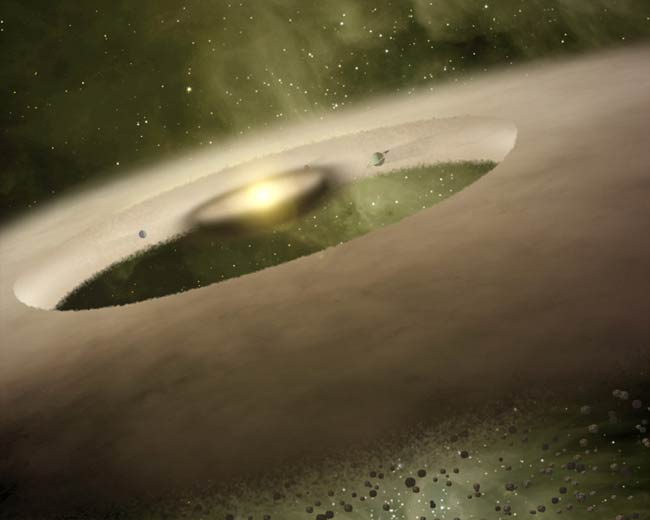Planet Formation is Child's Play

Astronomersthink they have found the two youngest solar systems ever detected, whereinfant planets could be sweeping up dust and creating voids in protoplanetarydisks 450 light-years from Earth.
NASA'sSpitzer Space Telescope observed the ring-like gaps, which could signal theearliest signs of rocky planet formation around two young stars located in theconstellation Taurus—UX Tau A and LkCa 15. Both stars are about 1 million yearsold, which is 10 times younger than other knownplanet-forming systems.
"Previously,astronomers were seeing holes at the centers of protoplanetary disks," saidCatherine Espaillat, an astronomer at the University of Michigan in Ann Arbor. Such holes are typically thought to be caused by photoevaporation, or stars burningdust away into light energy.
But insteadof central holes, Espaillat's team saw ring-like gaps in the spinning planetarymaterials.
"It'smore like a lane has been cleared within the disk. The existence of planets isthe most probable theory that can explain this structure," she said, asthe lanes are likely too distant from the star to photoevaporate.
The idea issimilar to touching a dusty record as it rotates, clearing a ring in the mat ofparticles; planets, however, use their growing gravity to sweep up the dust.
The Dec. 1issue of Astrophysical Journal Letters will detail Espaillat and hercolleagues' findings about the infant solar systems, which they said could helpexplain our own planet's past.
Get the Space.com Newsletter
Breaking space news, the latest updates on rocket launches, skywatching events and more!
"Weare looking for our history," said University of Michigan astronomer Nuria Calvet, who worked with Espaillat on the research."We are looking for the history of solar systems, trying to understand howthey form."
- Top 10 Most Intriguing Extrasolar Planets
- Hopes Dashed for Life on Distant Planet
- Habitable Planets: Disaster Zones and Safe Havens
Join our Space Forums to keep talking space on the latest missions, night sky and more! And if you have a news tip, correction or comment, let us know at: community@space.com.
Dave Mosher is currently a public relations executive at AST SpaceMobile, which aims to bring mobile broadband internet access to the half of humanity that currently lacks it. Before joining AST SpaceMobile, he was a senior correspondent at Insider and the online director at Popular Science. He has written for several news outlets in addition to Live Science and Space.com, including: Wired.com, National Geographic News, Scientific American, Simons Foundation and Discover Magazine.









